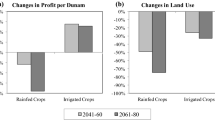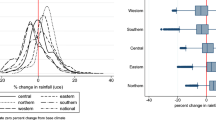Abstract
This study used a quadratic programming sector model to assess the integrated impacts of climate change on the agricultural economy of Egypt. Results from a dynamic global food trade model were used to update the Egyptian sector model and included socio-economic trends and world market prices of agricultural goods. In addition, the impacts of climate change from three bio-physical sectors – water resources, crop yields, and land resources – were used as inputs to the economic model. The climate change scenarios generally had minor impacts on aggregated economic welfare (sum of Consumer and Producer Surplus or CPS), with the largest reduction of approximately 6 percent. In some climate change scenarios, CPS slightly improved or remained unchanged. These scenarios generally benefited consumers more than producers, as world market conditions reduced the revenue generating capacity of Egyptian agricultural exporters but decreased the costs of imports. Despite increased water availability and only moderate yield declines, several climate change scenarios showed producers being negatively affected by climate change. The analysis supported the hypothesis that smaller food importing countries are at a greater risk to climate change, and impacts could have as much to do with changes in world markets as with changes in local and regional biophysical systems and shifts in the national agricultural economy.
Similar content being viewed by others
References
Adams, R., Rosenzweig, C., Peart, R., Ritchie, McCarl, B., Glyer, D., Curry, B., Jones, J., Boote, K., and Allen, H.: 1990, ‘Global Climate Change and U.S. Agriculture’, Nature 345, 219-223.
Adams, R., Fleming, R., Chang, C., McCarl, B., and Rosenzweig, C.: 1995, ‘A Reassessment of the Economic Effects of Global Climate Change on U.S. Agriculture’, Clim. Change 30, 147-165.
Biswas, A.: 1993, ‘Land Resources for Sustainable Agricultural Development in Egypt’, Ambio 22, 556-560.
Bowes, M. and Crosson, P.: 1993, ‘Consequences of Climate Change for the MINK Economy: Impacts and Responses’, Clim. Change 24, 131-158.
Broadus, J., Milliman, S., Edwards, D., Aubrey, D., and Gable, F.: 1986, ‘Rising Sea Level and Damming of Rivers: Possible Effects in Egypt and Bangladesh’, in Titus, J. (ed.), Effects of Changes in Stratospheric Ozone and Global Climate Volume 4: Sea Level Rise, United Nations Environment Programme and the U.S. Environmental Protection Agency, pp. 165-189.
Crosson, P. and Rosenberg, N.: 1993, ‘An Overview of the MINK Study’, Clim. Change 24, 159.
Darwin, R., Tsigas, M., Lewandrowski, J., and Raneses, A.: 1995, World Agriculture and Climate Change: Economic Adaptations, Agricultural Economic Report No. 703, U.S. Department of Agriculture, p. 86.
Eid, H. and Saleh, M.: 1992, Modeling of Climate Change Impacts on Egyptian Agriculture, Unpublished manuscript, International Institute for Applied Systems Analysis, Laxenburg, Austria, p. 15.
El-Raey, M., Nasr, S., Frihi, S., Desouki, S., and Dewidar, K.: 1995, ‘Potential Impacts of Accelerated Sea Level Rise on Alexandria Governorate, Egypt’, J. Coastal Res. 14, 190-204.
FAO (1991) AGROSTAT/PC, United Nations Food and Agricultural Organization, Rome, Italy.
Farag, S., McCarl, B., and Attia, B.: 1993, Investigation of New Land Development in the Egyptian Agricultural Sector, Department of Agricultural Economics, Texas A&M University, 24 March, p. 12.
Fischer, G., Frohberg, K., Keyzer, M., and Parikh, K.: 1988, Linked National Models: A Tool for International Food Policy, Kluwer Academic Press, IIASA, Laxenburg, Austria, p. 214.
Fischer, G., Frohberg, K., Parry,M. L., and Rosenzweig, C.: 1994, ‘Climate Change and World Food Supply, Demand, and Trade: Who Benefits, Who Loses?’, Global Environ. Change 4, 7-23.
Gleick, P.: 1991, ‘The Vulnerability of Runoff in the Nile Basin to Climate Changes’, Environ. Profess. 13, 66-73.
Hansen, B.: 1991, The Political Economy of Poverty, Equity and Growth: Egypt and Turkey, Oxford University Press, New York, Oxford, p. 572.
Hazell, P. and Norton, R.: 1986, Mathematics Programming for Economic Analysis in Agriculture, Macmillian Publishing, New York, pp. 164-165.
Humphries, J.: 1991, EASM91 - A Users Manual, Unpublished publications of the Egyptian Ministry of Public Works and Water Resources, Cairo, Egypt, p. 210.
Kulshreshtra, S. N.: 1993, World Water Resources and Regional Vulnerability: Impacts of Future Changes, RR9310, International Institute for Applied Systems Analysis, Laxenburg, Austria, p. 124.
Kutcher, G.: 1981, ‘Water Master Plan: The Agroeconomic Model’, Technical Report No. 16, UNDPEGY/ 73/24, Ministry of Irrigation, Cairo, Egypt.
Lofgren, H.: 1994, Personal Communication, American University of Cairo, Cairo, Egypt.
Mortsch, L., Koshida, G., and Tavares, D. L.: 1993, Adapting to the Impacts of Climate Change and Variability, Proceedings of the Great Lakes-St. Lawrence Basin Project, 9-11 February, 1993, Quebec City, Environment Canada, Downsview, Ontario, p. 69 + 2 Appendices.
Nemec, J. and Schaake, J.: 1982, ‘Sensitivity of Water Resource Systems to Climate Variation’, J. Sci. Hydrol. 27, 327-243.
Nicholls, R. and Leatherman, S.: 1995, ‘Global Sea Level Rise’, in Strzepek, K. and Smith, J. (eds.), As Climate Changes, International Impacts and Implications, Cambridge University Press, Cambridge, p. 92.
O'Mara, G. and Hawary, E.: 1992, The Response of Egyptian Farmers to Cotton Policy Intervention, A Report to the Egyptian Ministry of Agriculture and the United States Agency for International Development (October).
Onyeji, S. C.: 1992, A Socioeconomic Analysis of Integrated Climate Change Impacts in Egypt, A Report Prepared for the United States Environmental Protection Agency, p. 45.
Parry, M. L., Blantran de Rozari, M., Chong, A. L., and Panich, S.: 1992, The Potential Socio-Economic Effects of Climate Change in Southeast Asia, United Nations Environment Programme, Nairobi, Kenya, p. 126.
Phillips, T.: 1994, A Summary Documentation of the AMIP Models, Report No. 18, PCMDI, Lawrence Livermore National Laboratory, Livermore CA, UCRL-ID-116384, p. 343.
Rosenzweig, C. and Parry, M.: 1993, ‘Potential Impacts of Climate Change on World Food Supply: A Summary of a Recent International Study’, in Kaiser, H. and Drennen, T. (eds.), Agricultural Dimensions of Global Climate Change, St. Lucie Press, FL, pp. 87-116.
Rosenzweig, C.: 1994, Personal Communication, International Institute for Applied Systems Analysis, Laxenburg, Austria.
Rosenzweig, C. and Hillel, D.: 1994, Egyptian Agriculture in the 21st Century, CP-94-12, IIASA, Laxenburg, Austria, p. 29.
Rosenzweig, C., Parry, M., and Fischer, G.: 1995, ‘World Food Supply’, in Strzepek, K. and Smith, J. (eds.), As Climate Changes: International Impacts and Implications, Cambridge University Press, Cambridge, p. 27.
Said, R.: 1993, The River Nile: Geology, Hydrology and Utilization, Pergaman Press, Oxford, p. 320.
Samuelson, P.: 1952, ‘Spatial Price Equilibrium and Linear Programming’, Amer. Econ. Rev. 42, 283-303.
Strzepek, K., Oneyji, C., Saleh,M., and Yates, D.: 1995, ‘An Assessment of Integrated Climate Change Impacts onEgypt’, in Strzepek, K. and Smith, J. (eds.), As Climate Changes: International Impacts and Implications, Cambridge University Press, Cambridge, p. 180.
Strzepek, K. and Yates, D.: 1996, ‘Economic and Social Adaptations to Climate Change Impacts on Water Resources: A Case Study of Egypt’, Water Resour. Develop. 12, 229-224.
Yates, D.: 1996, Integrating Water into an Economic Assessment of Climate Change Impacts on Egypt, WP9631, International Institute for Applied Systems Analysis, Laxenburg, Austria, p. 52.
Yates, D. and Strzepek, K.: 1996, ‘Modeling Economy-Wide Climate Change Impacts on Egypt: A Case for an Integrated Approach’, Environ. Model. Assess. 1, 119-135.
Yates, D. and Strzepek, K.: 1997, ‘Modeling the Nile Basin under Climatic Change’, J. Hydrol. Engin., accepted for publication.
Author information
Authors and Affiliations
Rights and permissions
About this article
Cite this article
Yates, D.N., Strzepek, K.M. An Assessment of Integrated Climate Change Impacts on the Agricultural Economy of Egypt. Climatic Change 38, 261–287 (1998). https://doi.org/10.1023/A:1005364515266
Issue Date:
DOI: https://doi.org/10.1023/A:1005364515266




